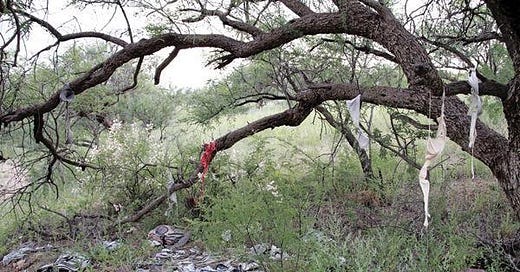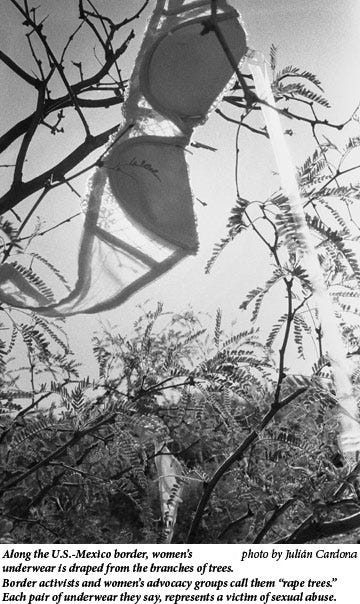Hello friends, please forgive us for bringing a very uncomfortable subject to your email inboxes. We were surprised and a little sorry to learn in the course of a conversation with someone who had some familiarity with the Border Crisis and Operation Lone Star, that they had no knowledge of the border’s “Rape Trees.”
On the basis of that conversation, we thought it merited some attention.
In this person’s defense, rape trees are not believed to be a common thing in the Del Rio Sector. They are most frequently found along the Border in Arizona, El Paso, and areas adjacent to the Rio Grande Valley.
There’s no clear reason why Del Rio and Kinney County are different, but one has a few guesses.
Above is a photo taken by photojournalist Karl W. Hoffman, of a mesquite somewhere in Arizona. There’s a lot going on in the photo, but, basically, we are told that women are pulled away from the group, bound to the tree, and used sexually. Many times the activity is instigated by the Coyote, inviting other men to participate. Sometimes other men pay in order to participate. Each bra or other piece of underwear left hanging from the tree represents an individual.
Why do they do this? It’s not clear— and reasons may vary from Coyote to Coyote. It may be as simple as keeping count— a barbaric means of bragging. It may also be done as a means of intimidating other women into complying with every last directive. Do what you’re told— or worse could happen to you.
The above photo is a bit more artistic. It comes from the Texas Observer. It’s interesting to note, that much of the coverage of this phenomenon over the years has come from progressive leaning organizations and activists. But, one doesn’t have to be a progressive to be repulsed by the knowledge.
It is in the discussion of what to do about it, that differences arise.
More on that, in just a moment.
Returning to what seems to be the special nature of the Ciudad Acuña - Del Rio area: It’s a fact that the cartels do not charge people extra to cross in Del Rio. It is also a fact that the area has not been marked by the kind of naked violence and barbarism seen in other areas as the cartels wage war with each other for territory. Don’t be mistaken— there is no doubt violence that occurs— but it is apparent that it is not so widespread or so savage as one might see in Matamoros, Reynosa, Nuevo Laredo, or other contested border cities.
There are several theories as to why, but in the end, it would seem that the criminal power structure in the area remains relatively civilized when compared to other areas. It may be as simple as there being some single figure in Acuña with the local control and muscle to enforce a less brutal way of doing business. Conversations with law enforcement sources locally, and higher up in Customs and Border Protection have yielded little insight into the matter— it may be that from the U.S. Government’s perspective, Ciudad Acuña’s inner workings are simply not a priority for investigation.
It’s hard not to fault someone reaching that conclusion, when other cities have been bleeding for more than a decade. Look no further than this NPR report from 2010: https://www.npr.org/templates/story/story.php?storyId=129234015
It could’ve been written yesterday as not a lot has changed.
While we are posting links— it’s worth looking at this video report from KABB in San Antonio— showing what happened last Summer when a Brooks County rancher discovered a rape tree on her property: https://www.youtube.com/watch?v=mLy3XvPO7XU
In the comments to that video, people describe their own experiences, stumbling across similar trees and not knowing what they meant. Brooks County is in the Falfurrias area— and saw more than 100 migrants perish in the heat last year.
And finally— there’s this article, in the New York Times from 2019, titled: “You Have to Pay With Your Body”: https://www.nytimes.com/2019/03/03/us/border-rapes-migrant-women.html
The article notes an estimation by then-President Trump, citing limited surveys, including one by “Doctors Without Borders” suggesting that 1-in-3 illegal alien women is a victim of rape.
What is to be done? Our more progressive associates at the Border Chronicle Substack, routinely call for “dignified” immigration, to take the place of what we have now. It sounds good, but, like anything the devil is in the details.
Certainly, there must be some concern that any sort of relaxed, more open, immigration policy could encourage even more risky behavior from desperate Central Americans. Witness what a simple change in Presidents has wrought.
It would seem that the obligation is on we the people— to somehow hash out just what level of immigration and assimilation the nation can sustain—to somehow quantify how much is too much. And to have some realistic appreciation for the place hard, firm, but fair enforcement of border controls must have in any conversation.
If border controls are not hard and firm, they will be tested— evaded— treated as they are now. And why wouldn’t they be? The unspoken message for as long as anyone can remember has been something like: “Keep trying until you make it.” And eventually, with enough persistence, many illegal aliens do. This has to change. In past dispatches, we’ve pointed out that the US is quite possibly absorbing numbers of Central Americans that dwarf the populations of certain states like Nebraska, South Dakota, and Wyoming. This is no good for the United States, and it is no good for Central America, representing a “brain drain” of some of their most motivated citizens.
The perception is that no matter what the Federal Government’s mouth may say— no matter what gestures it’s right hand is making— the left hand is busily covertly signaling for more people to keep right on coming. And until that changes, the border crisis will continue in some form or another.
We write this dispatch after dark, as the official Martin Luther King Federal Holiday draws to a close. In 1939, legendary jazz singer Billie Holiday sang the song “Strange Fruit.”
The opening lyrics are here:
“Southern trees bear a strange fruit
Blood on the leaves and blood at the root
Black bodies swingin' in the Southern breeze
Strange fruit hangin' from the poplar trees”
It’s a song about lynching. And the history of the song is something to read. And it should be a source of great shame for anyone to realize that trees along the border today still sometimes bear their own form of strange fruit. The women may survive their ordeal— but that is no excuse for the hollow, two-faced border policies that have persisted for so long and produced their own special, sick miseries.
Thanks for reading. We hope it’s been illuminating. We leave you now with the latest news release from the Kinney County Sheriff’s Office, documenting a busy weekend for Deputies and DPS troopers. And, as always, we hasten to point out that any opinions or errors expressed in this newsletter are entirely our own, and not indicative of Kinney County policies. Speaking of which, don’t hesitate to reach out for any corrections in the comments below, or by sending us a message in some other fashion.
We’ll see you again, sometime further on down the road.





